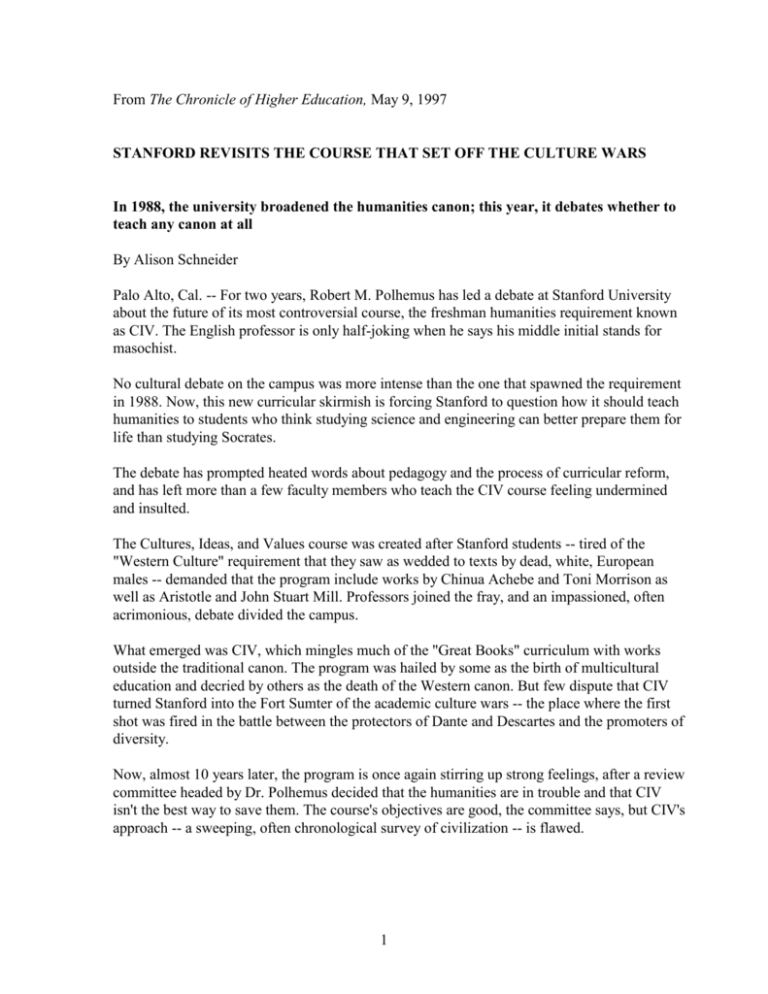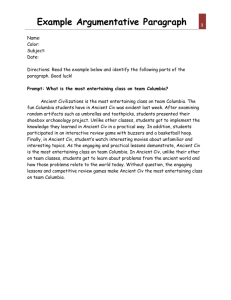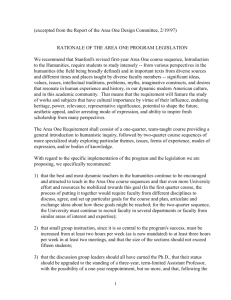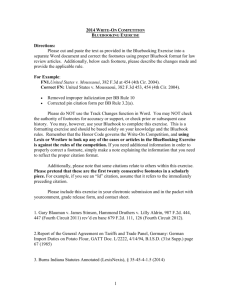From The Chronicle of Higher Education, May 9, 1997
advertisement

From The Chronicle of Higher Education, May 9, 1997 STANFORD REVISITS THE COURSE THAT SET OFF THE CULTURE WARS In 1988, the university broadened the humanities canon; this year, it debates whether to teach any canon at all By Alison Schneider Palo Alto, Cal. -- For two years, Robert M. Polhemus has led a debate at Stanford University about the future of its most controversial course, the freshman humanities requirement known as CIV. The English professor is only half-joking when he says his middle initial stands for masochist. No cultural debate on the campus was more intense than the one that spawned the requirement in 1988. Now, this new curricular skirmish is forcing Stanford to question how it should teach humanities to students who think studying science and engineering can better prepare them for life than studying Socrates. The debate has prompted heated words about pedagogy and the process of curricular reform, and has left more than a few faculty members who teach the CIV course feeling undermined and insulted. The Cultures, Ideas, and Values course was created after Stanford students -- tired of the "Western Culture" requirement that they saw as wedded to texts by dead, white, European males -- demanded that the program include works by Chinua Achebe and Toni Morrison as well as Aristotle and John Stuart Mill. Professors joined the fray, and an impassioned, often acrimonious, debate divided the campus. What emerged was CIV, which mingles much of the "Great Books" curriculum with works outside the traditional canon. The program was hailed by some as the birth of multicultural education and decried by others as the death of the Western canon. But few dispute that CIV turned Stanford into the Fort Sumter of the academic culture wars -- the place where the first shot was fired in the battle between the protectors of Dante and Descartes and the promoters of diversity. Now, almost 10 years later, the program is once again stirring up strong feelings, after a review committee headed by Dr. Polhemus decided that the humanities are in trouble and that CIV isn't the best way to save them. The course's objectives are good, the committee says, but CIV's approach -- a sweeping, often chronological survey of civilization -- is flawed. 1 Students choose one of nine tracks in the year-long program. There are tracks devoted to anthropology, history, literature, and philosophy. There's a section that focuses on the clash between Europe and the Americas; another delves into German thinking. In all of the tracks, students must read an epic, part of the Bible, a classical Greek philosopher, an early Christian thinker and one from the Enlightenment, a Renaissance dramatist, Marx, and Freud. Every track must require at least some works that address issues of race, class, religion, and gender, and they all must include texts by female and minority writers. The mission of CIV remains the same no matter which track a student takes. The course introduces students to the nature of cultures -- both Western and those of other parts of the world. It highlights the cultural and historical dimensions of issues affecting society, and it does all of those things while teaching students how to think about sophisticated texts and to write about them in equally sophisticated ways. Almost everybody at Stanford agrees that this is an impressive, even noble, set of goals. But the consensus crumbles on how well CIV achieves them. "We promise too much in those courses to follow through on everything," says Keith Baker, director of Stanford's humanities center and a member of the review committee. Students think so, too. In 1996, more than 60 per cent of those who answered a senior survey said the requirement had only slight to moderate value --a grim statistic for the only course that every Stanford undergraduate must take. Defenders of the program point out that only 465 seniors out of more than 1,600 responded to the survey, and that these students had taken CIV in the early '90s. Many tracks have improved since then, the defenders argue, and the ones that haven't are being used to tar the entire program. Nevertheless, the review committee took the complaints seriously. Students say there is not enough in common among the tracks, and not enough diversity within them. They complain that the teaching is hit or miss, the grading is inconsistent, and the workload varies. The biggest criticism is that the program tries to do too much in too little time, examining snippets of texts that, students say, leave them with only a superficial feel for the material. In a morning session of the "Humanities" track this spring, it is easy to see why students might think so. In less than an hour, the lecture jumps from Edmund Burke to Thomas Paine, with some passing references to Rousseau and Jefferson. The class will pause for "some time," the professor says, on page 69 of The Rights of Man. But, he quips, "in the framework of this course, 'some time' means 10 minutes." Indeed. Ten minutes later, he is on to Mary Wollstonecraft. Shortly thereafter, the students are hustling out the door. "This course makes you think about issues that are important to your life, but I feel like it could go into a lot more depth," says Will Shearin, a freshman in the "Humanities" track. "It's difficult to provide one course that teaches you about 1,000 years of literature in a year." 2 That isn't necessarily bad, says Carrie Dodson, a freshman in the "History" track. "CIV doesn't allow you to get an in-depth look at any one text. But the value of CIV isn't in learning how to evaluate literature, but in getting exposure to the broad development of ideas." As far as Dr. Polhemus's committee is concerned, the complaints of the Will Shearins weigh more heavily than the compliments of the Carrie Dodsons. The panel has proposed restructuring CIV, changing its format and sharpening its focus into what they call a "one-plustwo structure." In the new program, the first 10-week quarter would be team-taught and would focus on three to five texts. Students would immerse themselves for two to three weeks in a single book, examining it from a variety of perspectives -- literary, historical, and philosophical, for example. There would be no prescribed reading list, although at least one text in the first quarter would come from outside the Western canon. The overall goal: to teach students how humanists think by exposing them to the kinds of questions such scholars ask and the methodological approaches they use to find answers. Students would then move from the general to the particular in a two-quarter examination of specific themes and disciplines. The current CIV tracks could be adapted to the two-quarter structure, and new courses about, say, revolution or love or the Mediterranean basin might be developed. These tracks wouldn't provide a survey of civilization -- which reformers claim is one of the pedagogical pitfalls of the current program -- but rather would allow students to apply the skills they had developed in the first quarter. "We see a chance for much more depth rather than a kind of peep-show approach with great texts flickering by," says John Bender, an English professor and a member of the review committee. Smaller departments, which don't have enough professors to put together a three-quarter track, welcome the changes because they would be allowed to offer a two-quarter sequence. And students would no longer be locked into a year-long, three-quarter track as they are under the old system. But others say the new format doesn't make sense, since there would be no theme to weave the three quarters together, and no commonality of texts. "The new program is incoherent," says Paul S. Seaver, director of CIV since 1989. "No one is going to be able to figure out what the connection is of the first quarter to the second quarter. It's going to look like two different programs glued together." What really troubles some professors is that cultural breadth is being sacrificed for close readings. In the minds of many of the professors who teach it, CIV is a survey course. It is an introduction not only to the methods of humanistic inquiry, but also to the seminal works that have shaped humanistic thought. And for many of the tracks, chronology is key. How, some CIV professors ask, can Stanford compress the development of Western and non-Western 3 thought into two quarters? And how can it abandon its commitment to the commonality that comes from having at least a few prescribed texts? The reformers are unconvinced by those arguments. Professors who teach CIV, says Dr. Bender, are "not covering civilization, ideas, and values. It's impossible. The concept of coverage is an illusion." "We are redefining what the core means, and we're saying that the core of humanistic education is not whether you've read The Iliad or Dante. The core is whether you have the skills to read The Iliad or Dante. You can learn the skills to read Shakespeare by reading Sophocles." Dr. Polhemus puts it another way: "What we're trying to do is not to show every variety of fish, but to teach people how to go fishing." The proposal's critics, however, say it's tough to teach students to fish if they're afraid of the water. Freshmen, some CIV professors say, don't have the background to dive into analytical reading. "Fifteen or 20 books may be too much, but three to five is too little," Dr. Seaver says. "None of us who have taught freshman sections can imagine how we would spend nine hours on a single text." James A. Chokey, a teaching assistant in the "Humanities" track, concurs. "I think the folks on the committee do not have an understanding of what frosh are capable of intellectually. They're going to be lost." Some critics also think that the proposed program backtracks on CIV's lavish commitment to multicultural education. The preamble to the proposed course voices support for the "cultural breadth, diversity, and inclusiveness enacted in the 1988 reform." But that's where the explicit support begins and ends. Nowhere does the document state that all three quarters of the new course must include works by female and minority writers, or address issues of race, class, and gender. In part, the review committee wanted to prevent students from thinking that a book by a woman or a Chicano appeared on the syllabus only because it was required, says Dr. Baker, one of its members. "That ends up being a weird kind of tokenism." "There was a reason for the mandate 10 years ago," he says. "But if you look at what is being written about now in the humanities -- difference, race, gender -- those interests are now everywhere in the humanities. You don't really need to mandate what everybody is doing." "Not everything has to be in the legislation," says Condoleezza Rice, Stanford's provost. "It's hard to imagine how you can teach the kinds of issues you teach in the humanities without worrying about gender, race, class, nationality, religion." 4 Not only is it easy to imagine it, says Mary Louise Pratt, a professor in the "Europe and the Americas" track of CIV, but all you have to do is flip through the Stanford course catalogue to find plenty of humanities courses that are "completely monolithic." "The idea that it is inconceivable that there would be an introductory humanities course that lacks diversity," she says, "is, to me, starkly premature." Some professors speculate that the committee watered down the requirement for political, not pedagogical, reasons. Ten years ago, the debate over the course buried Stanford under an avalanche of bad publicity. William J. Bennett, then the Secretary of Education, called the program "an unfortunate capitulation to a campaign of pressure politics and intimidation." The result, supporters of the current CIV program say, is that the course was badly distorted in the public mind. Alumni grew suspicious of it; donors were turned off. And the administration was left with an albatross around its neck. "This is not a debate on the merits. There's been no intellectual discussion," says Carolyn Lougee Chappell, who headed CIV's "History" track but has resigned from the program to protest the review process. "The administration decided to get rid of the current course. It decided that before it staffed the committee." Provost Rice calls such claims "absolutely ridiculous." "I'm always struck when people say this was pushed from the top," she says, adding that members of the review committee are not "puppets to whom I surreptitiously passed ideas." In part, some faculty members who teach in the CIV program may be blaming the administration because they feel betrayed by the review process and belittled by the reforms. The review committee waited a full year before holding a public meeting with the CIV faculty, and when it did so, the encounters were infrequent. Many in the program felt that their concerns were not taken seriously. They say committee members never visited their lectures or sat in on discussion sections. "This should never have been a them-and-us situation," says Marsh McCall, a classics professor in the "Humanities" track. "But a large number of us who teach in the program felt that this was the mood from very early on. There was this committee that was going to come out with who knew what, and the people in the program were just helpless spectators on the sidelines." Some 30 professors and lecturers in the program signed a letter protesting the review process. But the Faculty Senate supported the work of the review committee, which included five members who have taught in the program. "Their voices were heard, and they were unpersuasive," Dr. Polhemus says. "They seemed to be provincial." 5 "If there's a debate, it's about turf," he says. "I've found that people who are wary of this committee, and change, will say anything to discredit our work." They may be doing so, he adds, because CIV faculty members dropped the ball on their own program. The changes would not have been necessary had CIV done a better job of policing its work and renewing itself, he says. What the reformers want the critics to realize is that many of the proposed changes are things that CIV professors have been asking for all along, like smaller discussion sessions and more money. CIV's $1-million-plus budget is expected to rise significantly. The review committee also has proposed that all discussion sections should be led by postdoctoral fellows, hired through a national search. Some sessions now are led by teaching assistants. The university's Committee on Undergraduate Studies is reviewing the proposed reforms and trying to resolve some of the conflicts. A key compromise would allow some tracks, in which chronology is important, to have three quarters to present material, albeit under the revised format. The Faculty Senate may vote on the plan by the end of this month. Despite the bumps, Dr. Polhemus remains optimistic that the proposal will be approved. He knows how important that is. Eighteen per cent of those in Stanford's entering class in 1996 are engineering students, 35 per cent are pre-med, and 38 per cent want to study the natural sciences. That doesn't leave many students for the humanities -- and small enrollments spell doom for suffering departments. The critics don't understand that "because Stanford does have such a techie side, humanities requirements are suspect," Dr. Polhemus says. "I took this on because I'm trying to speak up for the humanities and prevent this place from becoming Stanford Tech." Copyright 1997 by The Chronicle of Higher Education. Reprinted with permission. 6







